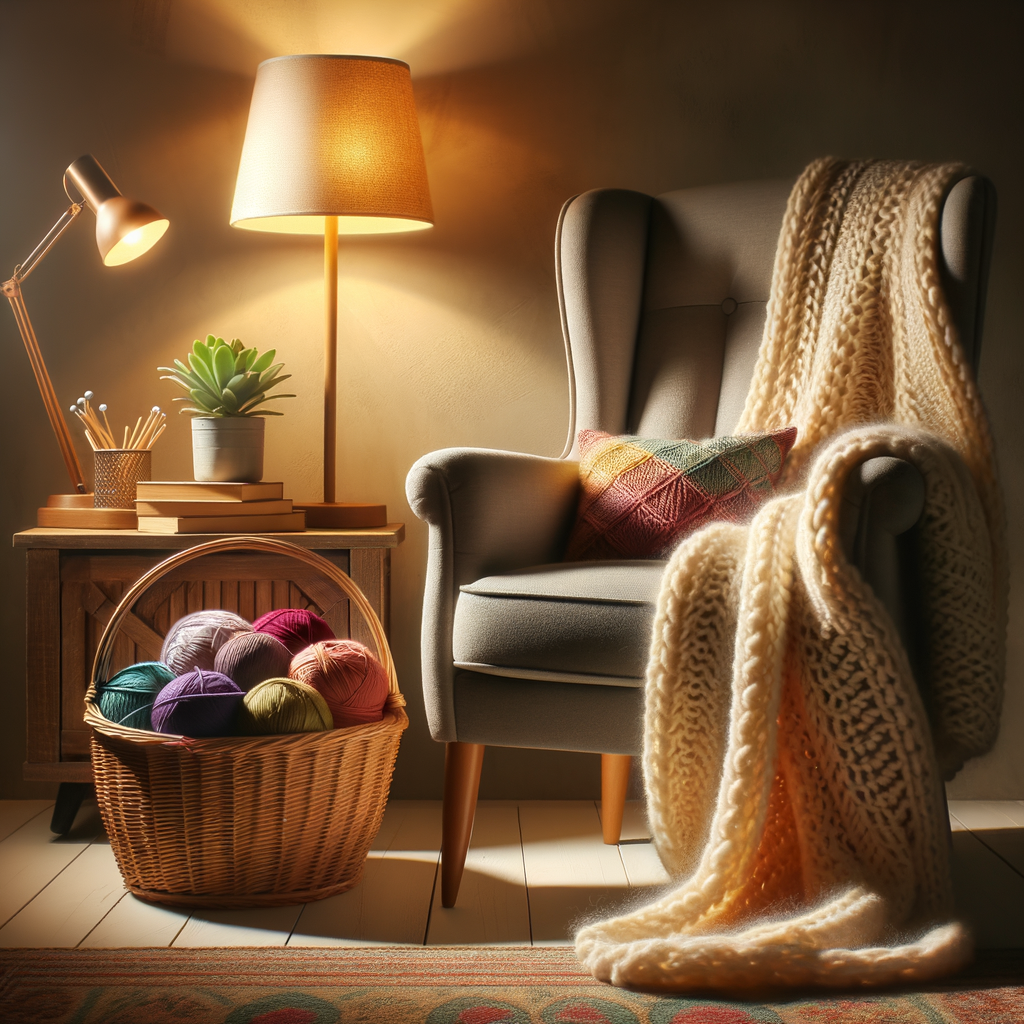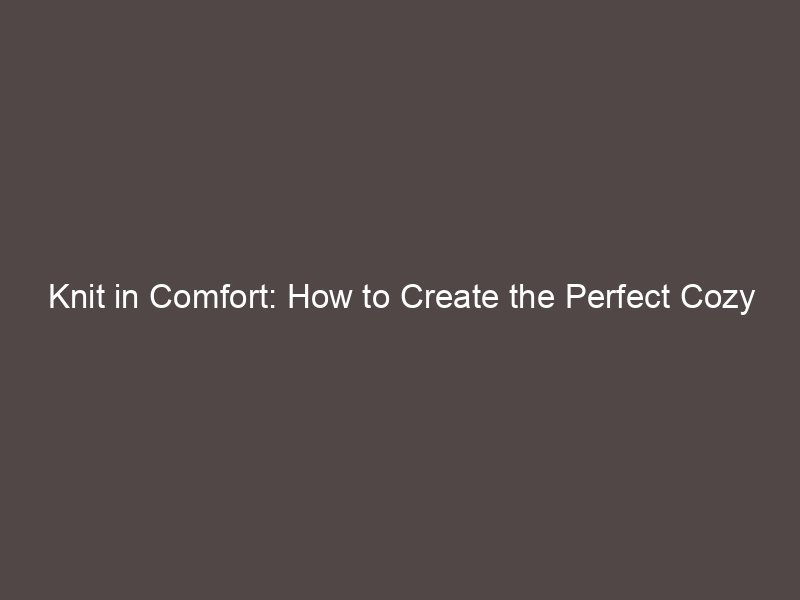
Introduction to Creating a Cozy Knitting Space
Welcome to the world of knitting, a place where creativity and comfort blend seamlessly. In this article, we will explore the importance of creating a cozy knitting space and how it can enhance your knitting experience.
- Importance of a comfortable knitting environment
- Overview of the article
Knitting is not just about creating beautiful pieces of art; it’s also about the experience. A comfortable and cozy knitting environment can make a significant difference in your knitting journey. It can help you focus better, reduce stress, and increase your productivity. Imagine sitting in a cozy corner of your home, with a warm cup of tea by your side, and your knitting tools in your hands. Doesn’t that sound relaxing? That’s the power of a comfortable knitting environment.
In this article, we will delve into the world of knitting and explore how to create a cozy knitting space. We will discuss the importance of understanding the knitting experience and how to enhance your knitting environment. We will provide you with tips and tricks to make your knitting space as comfortable and inviting as possible. Whether you are a beginner or an experienced knitter, this article will provide you with valuable insights to improve your knitting experience.
So, get ready to transform your knitting space into a cozy haven that inspires creativity and relaxation. Let’s embark on this exciting journey together!
Understanding the Knitting Experience
Knitting is more than just a hobby or a way to pass time. It’s an experience that can have profound psychological benefits. Let’s delve into these benefits and understand how knitting can improve our mental well-being.
Psychological Benefits of Knitting
Knitting can be a therapeutic activity that offers numerous mental health benefits. Here are some of the key psychological benefits of knitting:
- Stress relief: Knitting can be a calming activity that helps to reduce stress and anxiety. The repetitive motion of the needles and the focus required to follow a pattern can create a sense of calm and relaxation. According to a survey conducted by the British Journal of Occupational Therapy, 81% of respondents reported feeling happier after knitting.
- Boosting creativity: Knitting allows you to express your creativity. Whether you’re following a pattern or creating your own design, knitting gives you the opportunity to make something unique and beautiful. This creative outlet can boost your mood and self-esteem.
- Improving concentration: Knitting requires focus and attention to detail, which can help improve your concentration skills. This can be particularly beneficial for children and adults with attention deficit disorders. A study published in the Journal of Neuropsychiatry and Clinical Neurosciences found that crafting activities like knitting can stimulate the brain and improve cognitive function.
In conclusion, knitting is not just about creating beautiful items, it’s also about improving your mental well-being. So, the next time you pick up your knitting needles, remember that you’re not only crafting a beautiful piece, but also boosting your mental health.
Physical Comfort in Knitting
While the psychological benefits of knitting are well-known, it’s equally important to consider the physical aspects of this activity. Ensuring physical comfort while knitting can enhance your overall experience and help you knit for longer periods without discomfort. Let’s delve into some key factors to consider.
- Importance of Good Posture
- Proper Lighting
- Choosing Comfortable Seating
Good posture is crucial when knitting. Slouching or hunching over your knitting project can lead to back and neck pain over time. To maintain good posture, sit upright with your back straight and shoulders relaxed. Your knitting project should be at a comfortable height, ideally at chest level, to avoid straining your neck and eyes. Remember to take short breaks every 30 minutes to stretch and relax your muscles.
Proper lighting is another essential aspect of physical comfort in knitting. Working in a well-lit environment can prevent eye strain and make it easier to see your stitches. Natural light is the best option, but if you’re knitting in the evening, ensure you have a good quality desk lamp. The light should be bright enough to see your work clearly but not so bright that it causes glare.
Where you sit can greatly impact your knitting experience. Choose a chair that supports your back and has a comfortable cushion. Your feet should be flat on the floor, and your knees should be at a right angle. This position helps maintain good posture and reduces the risk of back pain. If possible, opt for a chair with armrests to support your arms while knitting.
In conclusion, physical comfort in knitting is just as important as the psychological benefits. By maintaining good posture, ensuring proper lighting, and choosing comfortable seating, you can enhance your knitting experience and enjoy this activity to the fullest.
Enhancing Your Knitting Environment
Knitting is not just a hobby, but a form of relaxation and creative expression. To fully enjoy this craft, it’s important to create an environment that enhances your knitting experience. Let’s explore how you can create a cozy atmosphere for your knitting sessions.
Creating a Cozy Atmosphere
- Choosing the right location: Your knitting space should be a place where you feel comfortable and relaxed. It could be a corner of your living room, a dedicated craft room, or even a sunny spot in your garden. Choose a location that’s quiet and free from distractions.
- Decorating your knitting space: Personalize your knitting space with items that inspire you. This could be pictures of your favorite knitting projects, a vase of fresh flowers, or a mood board with color swatches and patterns. Make it a space that sparks your creativity.
- Creating a knitting ambience with music or podcasts: Background noise can enhance your knitting experience. You might enjoy listening to calming music, engaging podcasts, or even the soothing sounds of nature. Experiment with different sounds to see what you enjoy most.
- Storage solutions for knitting supplies: Keep your knitting supplies organized with smart storage solutions. This could be a set of drawers for your yarn, a pegboard for your knitting needles, or a basket for your unfinished projects. An organized space will make your knitting sessions more enjoyable.
- Keeping your knitting space tidy: A clean and tidy space is essential for a relaxing knitting experience. Make it a habit to clean up after each knitting session. This way, you’ll always be ready for your next project.
- Comfortable knitting needles: The right knitting needles can make a big difference in your knitting experience. Choose needles that are comfortable to hold and suitable for your yarn and project. There are many types to choose from, including bamboo, metal, and plastic.
- Quality yarn for a better knitting experience: The quality of your yarn can greatly affect the outcome of your projects. Choose yarns that are soft, durable, and easy to work with. Experiment with different types and brands to find your favorites.
- Choosing clothes that won’t interfere with your knitting: When knitting, it’s best to wear clothes that won’t snag your yarn or interfere with your movements. Opt for comfortable and loose-fitting clothes that allow you to move freely.
- Considering temperature and fabric: The temperature of your knitting space and the fabric you’re working with can affect your comfort level. Make sure your space is at a comfortable temperature and choose yarns that are suitable for the current season.
- Background: The idea of creating a cozy knitting environment came from the need to make knitting more enjoyable and less stressful. It’s based on the understanding that our surroundings can greatly affect our mood and productivity.
- Steps taken: The steps taken to create a cozy knitting environment include choosing the right location, decorating the space, creating an ambience, organizing supplies, keeping the space tidy, choosing comfortable needles and quality yarn, and considering the temperature and fabric.
- Results and key takeaways: The result is a cozy and inviting knitting environment that enhances the knitting experience. The key takeaway is that a well-organized and personalized space can make knitting more enjoyable and productive.
- Background: The concept of creating a cozy knitting environment has been embraced by knitters worldwide. It’s based on the belief that a comfortable and inspiring environment can enhance creativity and relaxation.
- Steps taken: The steps taken to create a cozy knitting environment include personalizing the space, creating a soothing ambience, and organizing supplies. The result is a space that’s not only functional but also inspiring and relaxing.
- Results and key takeaways: The result is a knitting environment that’s conducive to creativity and relaxation. The key takeaway is that a well-thought-out knitting space can enhance your knitting experience and make it more enjoyable.
- Recap of the article: This article has provided tips on how to enhance your knitting environment by creating a cozy atmosphere. It has covered aspects such as choosing the right location, decorating your space, creating an ambience, organizing supplies, and choosing comfortable needles and quality yarn.
- Final thoughts on creating a cozy knitting atmosphere: Creating a cozy knitting atmosphere is about more than just organizing your supplies. It’s about creating a space that inspires you, relaxes you, and enhances your knitting experience. So, take the time to create a knitting environment that’s just right for you.






